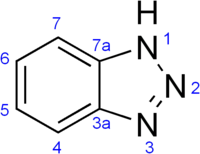
Photo from wikipedia
In a previous publication (Sorbie and Stamatiou in Transp Porous Media 123:271–287, 2018), we presented a one-dimensional analytical solution for scale inhibitor transport and retention in a porous medium through… Click to show full abstract
In a previous publication (Sorbie and Stamatiou in Transp Porous Media 123:271–287, 2018), we presented a one-dimensional analytical solution for scale inhibitor transport and retention in a porous medium through a kinetic precipitation mechanism. In this process, a chemical complex of the scale inhibitor precipitates within the porous matrix and it then re-dissolves through a kinetic solubilisation process. Considering the re-dissolution of this precipitate in a one-dimensional linear system such as a reservoir layer or indeed in a laboratory core/pack flood, the flowing aqueous phase gradually dissolves the precipitate which is then eluted from the system. The most novel aspect of this previous analytical solution arose from the fact that, at a certain point in time (or pore volume throughput), the precipitate in the system was locally fully re-dissolved, forming an internal moving boundary between where no precipitate remained (closer to the system inlet) and where a precipitate was present (further into the system up to the outlet). In the current paper, we extend this work by presenting analytical solutions for the case where precipitation/dissolution occurs simultaneously with an adsorption/desorption interaction between the scale inhibitor and the rock surface, described by the nonlinear Langmuir isotherm. When examining this more complex problem in the flow scenario where the local precipitate is completely dissolved, several interesting analytical solution structures are obtained as a result of the internal moving boundary. Which of these structures occurs is rigorously categorised according to the solubility, the initial levels of precipitate and adsorbate, as well as the shape of the Langmuir isotherm. After the mathematical development of the analytical solutions, they are applied to some example problems which are compared with numerical solutions. Finally, a number of different generic features in the scale inhibitor effluent concentration profile are predicted and discussed with regard to practical field applications.
Journal Title: Transport in Porous Media
Year Published: 2020
Link to full text (if available)
Share on Social Media: Sign Up to like & get
recommendations!